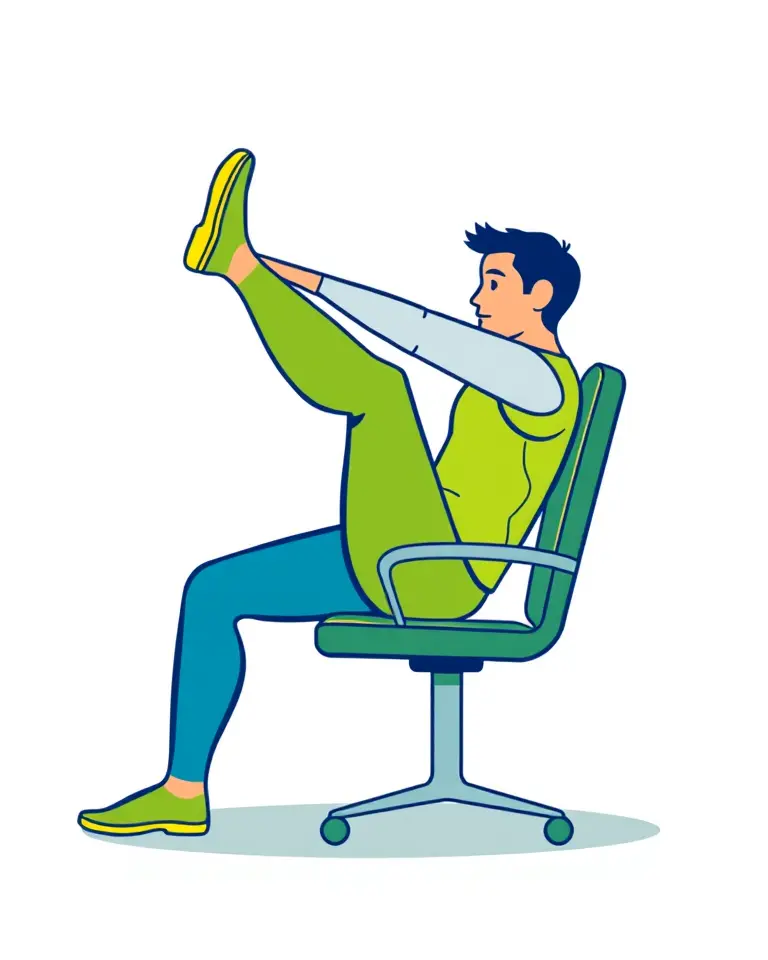The humble chair, often associated with rest and relaxation, can surprisingly be transformed into a powerful tool for fitness. Whether you’re a senior looking for low-impact ways to stay active, someone recovering from an injury, or simply seeking a convenient way to incorporate movement into your day, chair exercises offer a versatile and effective solution. This guide explores various chair-based exercises, their benefits, and how to integrate them into your routine.
The Benefits of Chair Exercises
Chair workouts provide a multitude of advantages, making them suitable for people of all ages and fitness levels.
Accessibility and Convenience
Chair exercises are incredibly accessible. They require no special equipment beyond a sturdy chair, making them easy to perform at home, in the office, or while traveling. This convenience eliminates common barriers to exercise.
Low-Impact Nature
Many chair workouts are low-impact, minimizing stress on joints. This is particularly beneficial for seniors, individuals with joint pain, or those recovering from injuries who may find high-impact exercises difficult.
Strength Building
Despite being low-impact, chair exercises can effectively build muscle strength. By using your body weight and the chair’s stability, you can work major muscle groups in your arms, legs, and core.
Improved Flexibility and Balance
Chair-based stretches and movements can enhance flexibility, improve posture, and boost balance. These are vital for maintaining mobility and reducing the risk of falls, especially for older adults.
Increased Circulation and Energy
Chair workouts can boost circulation and increase energy levels. Even gentle movements can get your heart pumping and improve blood flow, which supports overall health.
Types of Chair Workouts
Chair workouts are flexible and customizable, allowing you to focus on various fitness goals.
Strength-Focused Workouts
These workouts target muscle building using the chair for support and leverage. Examples include:
- Tricep Dips: Using the chair seat to perform dips, effectively work your triceps and shoulders.
- Seated Leg Raises: Engaging your core and leg muscles by lifting and lowering your legs while seated.
- Modified Push-ups: Using the chair to perform modified push-ups targets the chest, shoulders, and triceps.
Cardio-Enhancing Workouts
While seated, you can still get your heart rate up:
- Seated Marches: Lift each knee alternatively, mimicking a marching motion, to elevate your heart rate.
- Seated Punches/Jabs: Punch forward while seated to get your blood flowing and build upper body strength.
- Alternating Knee Lifts: Lift knees towards your chest alternating between each leg to increase cardio intensity.
Flexibility and Stretching
Chair-based stretches can improve range of motion and flexibility:
- Seated Twists: Gently twist your torso while seated to stretch your back and core.
- Seated Side Bends: Bend to each side, stretching the obliques and improving lateral flexibility.
- Chest Stretch: Extend your arms out to the sides, gently pushing your chest forward and up for a beneficial stretch.
Essential Chair Exercises
Here’s a detailed look at some of the most effective chair exercises:
Lower Body Exercises
- Chair Squats: Stand in front of the chair, lower yourself as if you’re about to sit, stopping just before touching the seat, then stand back up. This exercise helps build strength in your legs and glutes and improves balance.
- Seated Leg Extensions: Extend one leg straight out in front of you while seated, engaging the thigh muscles.
- Heel Slides: While seated, slide your heels forward and back, working on leg flexibility and joint movement.
- Seated Calf Raises: Lift your heels off the floor, engaging your calf muscles. You can also try single-leg variations for a greater challenge.
- Heel and Toe Raises: Standing with the support of the chair, alternate between raising up on your toes and then your heels to improve lower leg strength and balance.
- Hip Marching: Lift each knee up alternatively toward your chest to strengthen your hips and thighs, as well as enhance flexibility.
Upper Body Exercises
- Seated Shoulder Press: Use light weights or resistance to work out your shoulders by pushing the weights up from shoulder height.
- Seated Front Shoulder Raises: Lift light weights or cans in front of you to shoulder height, strengthening the front of your shoulders.
- Seated Chest Press: Press weights away from your chest while seated to engage your chest and arm muscles.
- Seated Rows: Lean forward slightly, pull your elbows back, squeezing the shoulder blades together, working back and shoulder muscles.
Core Strengthening Exercises
- Seated Tummy Twists: Rotate your torso from side to side while seated, engaging your core muscles.
- Modified Planks: Place hands on the chair seat and hold a plank position, engaging core and stabilizing muscles.
- Extended Leg Raises: While seated, extend your legs straight, engage your core and lift one leg at a time.
How to Safely Perform Chair Exercises
Proper form and safety are crucial to prevent injuries and maximize benefits:
Choose the Right Chair
Opt for a sturdy chair without wheels and with a solid back for support. Ensure the chair is stable and can support your weight.
Warm-Up
Start with light warm-up exercises like seated marches or gentle stretches to prepare your body.
Proper Form
Maintain correct posture and form during each exercise. This will help target the right muscles and prevent injuries.
Listen to Your Body
If you experience pain, stop immediately. Do not push yourself too hard, especially when starting.
Start Gradually
Begin with a few repetitions of each exercise and gradually increase as your strength and stamina improve.
Consistency
Aim to incorporate chair exercises into your routine regularly, at least two to three times per week, to see noticeable improvements.
Chair Exercises for Different Needs
Chair exercises can be modified to suit different fitness goals and needs.
For Seniors
Gentle chair workouts can help seniors maintain independence and mobility, enhance balance, and improve overall health. Focus on low-impact exercises and stretches that improve flexibility, strength and circulation.
For Beginners
Start with basic exercises and gradually increase the intensity and repetitions as you become more comfortable. Aim for shorter workouts and focus on mastering proper form.
For those with mobility issues
Chair workouts allow people with limited mobility to exercise comfortably without putting excessive strain on their joints. These exercises can improve muscle strength, flexibility, and cardiovascular health.
For Advanced Exercisers
Increase the intensity by adding weights or resistance bands. Advanced exercisers can also increase the reps and sets, or add more challenging variations of the exercises.
Incorporating Chair Exercises into Your Routine
Integrating chair exercises into your daily life is straightforward:
Short Bursts
Perform a few chair exercises during short breaks throughout the day. This can make a significant difference in your overall activity levels.
As Part of a Full Workout
Incorporate chair exercises into a full body workout routine. You can alternate chair-based exercises with other types of activities.
While Watching TV
Engage in a chair workout while watching your favorite shows. This combines leisure with physical activity.
At Work
Take short breaks to do seated stretches or strength exercises at your desk to combat the effects of prolonged sitting.
Conclusion
Chair exercises offer a practical, effective, and accessible way to improve your fitness, regardless of your age or physical condition. By incorporating these exercises into your daily routine, you can build strength, enhance flexibility, and boost your overall health without the need for expensive equipment or a gym membership. Remember to listen to your body, focus on proper form, and enjoy the process of transforming your chair into a fitness powerhouse.







